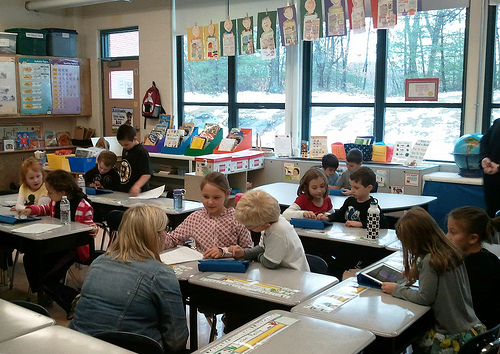Technology in the Classroom The Benefits of Blended Learning
Timothy Huneycutt |
October 8, 2013
As we advance further into the 21st century, technology is becoming more and more integrated into our society. Smart phones are now commonplace, tablets are replacing or substituting for computers and laptops, and social media has become second nature. The rapid and widespread adoption of these technological innovations has completely changed the way we conduct our daily lives, including how knowledge is digested and taught in our classrooms – but is it a positive change? Should we be worried about teachers and students using technology in the classroom? Our mathematics coordinator and NMSI expert, Jeremy Posey, digs deep and shares some knowledge on how technology can benefit your students.
[Jeremy]: To begin with, let’s define technology in the classroom. Technology can be defined as any tool that can be used to help promote human learning, including – but not limited to – calculators, tablets (such as an iPad), Smart Boards, video cameras, digital cameras, MP3 players, Portable Digital Assistants (PDAs), and, of course, the computer. These are all innovations that have helped countless people during regular daily activities, but they can also have a profound impact on classroom learning.
Overall, integrating technology into the classroom helps prepare our students for the elaborate world they will face going forward, but there are also four specific benefits to using technology in the classroom:
1.It can keep students focused for longer periods of time. The use of
Students engaging in groups with iPads in the classroom.
Photo by Matt Malone
computers to look up information/data is a tremendous time saver, especially when used to access a comprehensive resource like the Internet to conduct research. This time-saving aspect can keep students focused on a project much longer than they would with books and paper resources, and it helps them develop better learning through exploration and research.
2.It makes students more excited to learn. When technology is integrated into school lessons, learners are more likely to be interested in, focused on, and excited about the subjects they are studying. Subjects that might be monotonous for some – like math and science – can be much more engaging with virtual lessons, tutoring, and the streaming of educational videos. Check out our free lessons page! We just updated it with brand new content that we believe will be a tremendous benefit to you and your students.
3.It enables students to learn at their own pace. With the integration of technology, students are able to get direct, individualized instruction from the computer. This form of supplemental teaching allows them to engage with the information at times that are most convenient for them and helps them become more self-directed in the learning process. It also gives the teacher more time to accomplish classroom objectives, while freeing them up to help the students who might be struggling with certain lessons.
4.It prepares students for the future. By learning to use technology in the classroom, both teachers and students will develop skills essential for the 21st century. But more than that, students will learn the critical thinking and workplace skills they will need to be successful in their futures. Education is no longer just about learning and memorizing facts and figures; it’s about collaborating with others, solving complex problems, developing different forms of communication and leadership skills, and improving motivation and productivity.
 Of course, as with anything, there are also some perceived negative aspects to using technology in the classroom, such as abusing internet privileges for non-school related activities. However, in most cases, the pros largely outweigh the cons. The best way to guard against any negative effects of technology integration and implementation is to make sure teachers and students are trained on the proper use and etiquette of the resources. Teachers should always understand how and why each piece of technology is being used by their students, and they should monitor student activities to the best of their abilities. Nothing is perfect, and we certainly shouldn’t diminish the roles of traditional learning processes – such as handwriting – but when used correctly, technology can help both teachers and students soar to success.
Of course, as with anything, there are also some perceived negative aspects to using technology in the classroom, such as abusing internet privileges for non-school related activities. However, in most cases, the pros largely outweigh the cons. The best way to guard against any negative effects of technology integration and implementation is to make sure teachers and students are trained on the proper use and etiquette of the resources. Teachers should always understand how and why each piece of technology is being used by their students, and they should monitor student activities to the best of their abilities. Nothing is perfect, and we certainly shouldn’t diminish the roles of traditional learning processes – such as handwriting – but when used correctly, technology can help both teachers and students soar to success.
Click the button to Tweet! - Education is no longer memorizing facts on paper; it's engaging with students through technology. #edchat